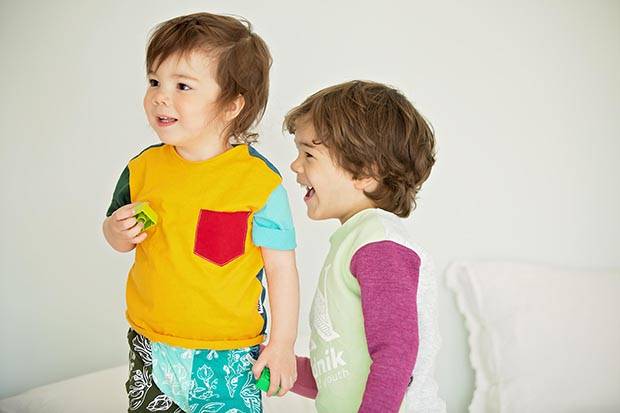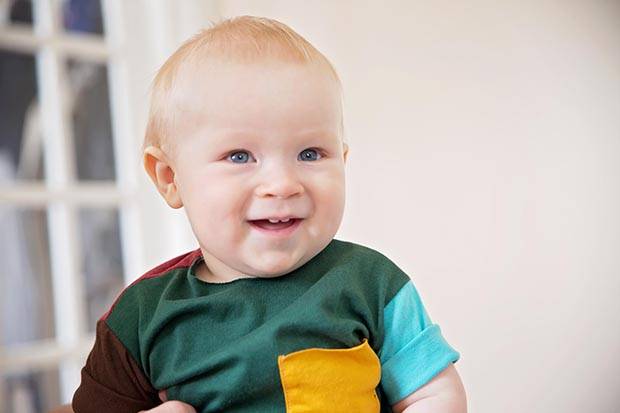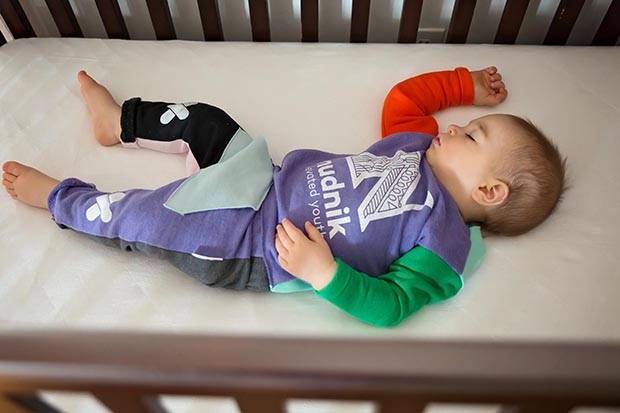Sustainable practices are gaining traction in the fashion world as labels scramble to try and soften the blow the apparel industry is dealing to the planet. Enter Toronto twin sisters Lindsay and Alexandra Lorusso, whose father Carl Lorusso co-founded the waste management company Wasteco in 1978. Lindsay and Alexandra, who grew up in Tottenham, Ont., began working for their dad in their early 20s, learning firsthand about material excess and waste.
The sisters, now 34, are poised to start changing the hearts and minds of a new generation with their upcycled kids' label, Nudnik. Launched less than a year ago, the fledgling clothing company – which has so far concentrated on outfitting children aged 3-months to 3-years – is set on manufacturing all its products locally using only textiles sourced from waste management and used clothing distribution centres, material that would otherwise end up in landfill. The Larussos collaborate with local artists to create original prints, and many of their pieces are based on trendy patchwork or colour-blocked designs with raw edges, so no new materials are needed.
This past spring, Nudnik was accepted into the Joe Fresh Centre for Fashion Innovation, which, in conjunction with Ryerson University, aims to assist Canadian startups by offering mentorship and support. And this fall, Nudnik's size range will expand to dress kids up to age 5. I caught up with the visionary sisters to talk about the shifting consciousness when it comes to sustainable fashion, and new ways of looking at old materials.
We don't readily relate the fashion world to the waste management world. What made you want to start a fashion label?
Lindsay: The women on our mom's side of the family are very stylish. They're very into fashion and design. We grew up outside of Toronto, but our mom would bring us into Kensington Market and to Queen Street to find prom dresses and interesting little finds that were different from what other kids were wearing back home. And being twin sisters, fashion was a way for us to differentiate ourselves from one another from very early on. We were never the types of twins that dress the same. Our father really instilled the sense of humility, hard work, determination, and entrepreneurial spirit within us. I think those two things coupled together brought us to where we are.
When did you start to realize that clothing was polluting the planet?
Alexandra: At our work experience with Wasteco. We started to see that textile waste wasn't being utilized. It was all going into the waste stream. It was perfectly good material but there was no home for it. We thought there was a huge opportunity to be able to create something and be a bit innovative with that material. Toronto's actually one of the hubs now for importing and exporting that material, so being in the city and having unlimited access to a lot of these materials, it was just a natural fit. We liked the idea of kids' clothing because I'm a new aunt and my sister has children. Kids' clothing made sense because we'd be able to utilize these smaller scraps as well.

The brand will expand its size range to cover children aged three months to five years this fall.
LAUREN HARDY
After working at Wasteco together, what gave you the impetus to want to spread your own wings and fly in your own direction?
L: I think that we've always wanted to do something together. When we look back, it looks like we've had this education together within the waste management world of learning how to run a successful business – the chops it takes, the dedication it takes and we feel ready. We feel really ready to do our own thing. This new business allows us to use our creativity more than we've ever been able to before, which is very exciting for us and it's very close to home. We're dealing with children, we're dealing with families, we're dealing with communities, we're dealing with fashion. All these elements are very important to us as individuals as well.
A: And we can really thank our father for that entrepreneurial spirit. I think he always knew we would be doing something of own someday. We've come up with many ideas over the years and I think this one just made sense and it's stuck and it's just a bit serendipitous how it all came together.
What about your design inspiration?
L: The most exciting thing for us is creating this experience for young children and their parents that we don't see that often yet. We're creating this experience that children have unlimited potential to tap into their imaginations. We use a lot of colour. We base a lot of our designs on early childhood education, different patterns, building these worlds through different imagery. And we're really hoping to then take that, and create a digital experience later on. We're trying to build this brand that excites parents to raise our next generation of future leaders, future activists. Kids who can wear any colour, who can dream any dream.
I suppose the biggest challenge is competing with people who are putting a lot of stuff out there at a very low price, because they're manufacturing offshore. How do you find your customer
L: We really feel that we have customers out there who believe that if they purchase something, it's a lifetime purchase in a way. We want these things to be able to be passed down from child to child, children within your own community or children to friends, because we're taking this fabric that has a story and we're almost continuing that story by reworking it and rejigging it. And we're hoping that story doesn't necessarily have an end as well. We're hoping to inspire the parents that would like to pay a little bit more money to buy into a brand that is really doing good as well.

Nudnik’s founders say they’d like to expand the brand to women’s and men’s clothing in the future.
LAUREN HARDY
Why do think there aren't more people doing what you're doing?
L: We have such an advantage coming from an industry where sustainability is paramount. We've really seen a shift from waste collection to recyclables in the last number of years and I think that's a mindset that we really have inherited and we're bringing that into fashion. We're trying to redefine that concept of new. We believe materials that have been used before are equal to those of raw value and we're trying to showcase the ability to be able to use those products and create awesome, new and exciting things.
What about looking at creating a clothing line for women and using these same principles?
L: We'd love to do an extension of Nudnik and get into women's wear, men's wear, homeware. We love the idea of creating a lifestyle brand using upcycled materials, and children are our starting point. We're very excited about that. We'd love to design for many other avenues.
Visit tgam.ca/newsletters to sign up for the Globe Style e-newsletter, your weekly digital guide to the players and trends influencing fashion, design and entertaining, plus shopping tips and inspiration for living well. And follow Globe Style on Instagram @globestyle.

